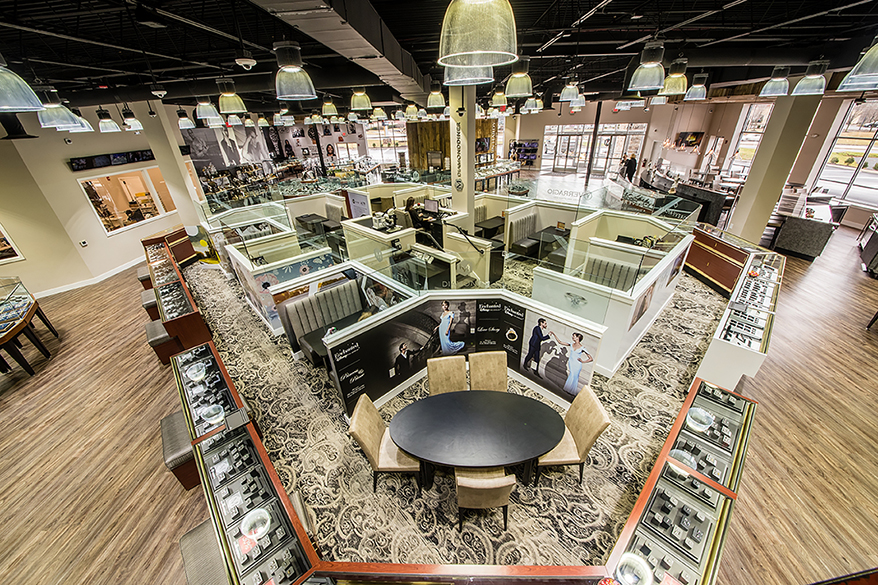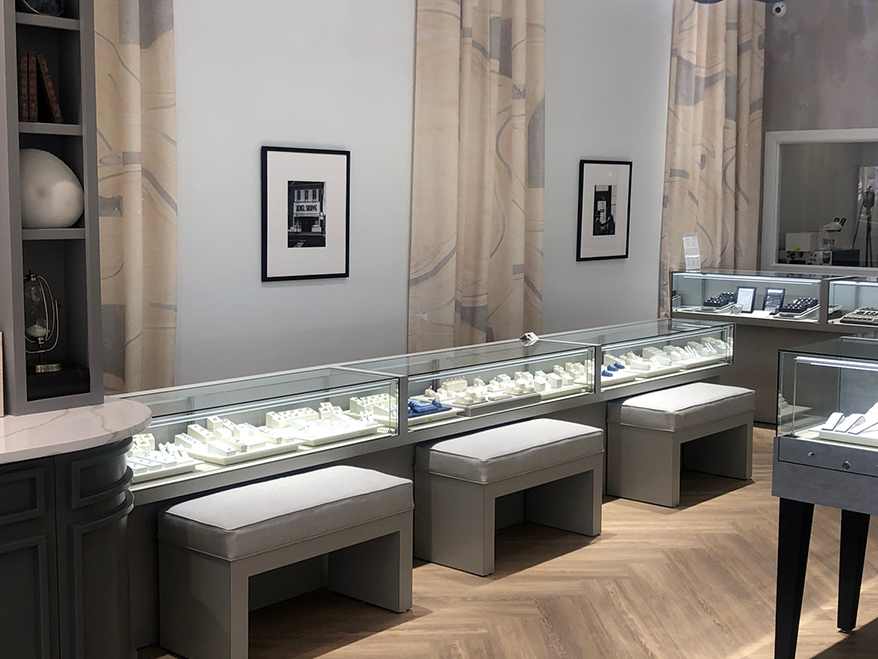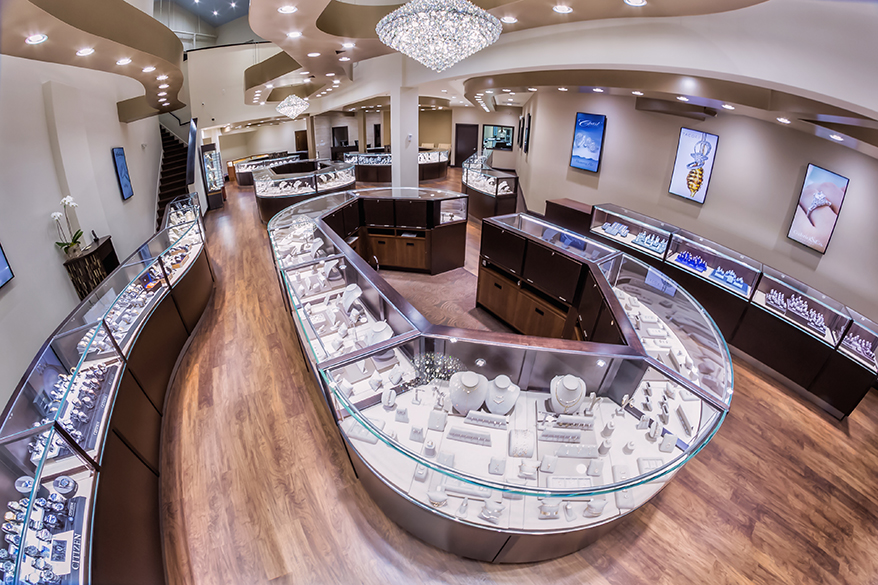DESIGNING A SHOWCASE layout that creates the best customer experience presents a variety of challenges. Jewelry store owners and interior designers are meeting those challenges by using stand-alone showcases that allow shoppers to view jewelry from different angles and sales associates to stand side by side with them for consultations.
“A shoulder-to-shoulder approach to sales is breaking down the barrier between the client and the sales staff,” says Keely Grice of Grice Showcase. “It’s much more personal and friendly.”
This strategy is also a good use of space, says interior designer Leslie McGwire, because this type of case can be placed just 2 feet from a wall, while a traditional case setup requires 6 feet behind it.
Another consideration is height. Most cases should be 42 inches tall for optimal viewing, McGwire says, while sit-down showcases work best at 36 inches.
Here are some notable examples that contribute to the customer experience.

Lighten Up
Hyde Park Jewelers’ new 4,400-square-foot location in Scottsdale, AZ, was designed by RDH Interests and Icon Designs & Fixtures to achieve a maximum density of display cases and products while lightening the look of the cases by eliminating their bases. Also eliminated is the visual barrier of metal glass frames, creating a glass-on-glass look. Curved and squared case configurations create visual interest. Perimeter displays were designed so that each brand had design latitude for its own cases, which were then seamlessly incorporated into the common design for the wall cases. The store is owned by Damon Gross.

Flexible Floor
Jim and Dareen Brusilovsky, owners of Marks Jewelers in Montgomeryville, PA, wanted their four-sided glass showcases to be totally mobile in their expansive 15,000-square-foot space. They achieved their goal, allowing for more than two dozen floorplan changes in the store’s first 18 months. Those moves take place around inventive permanent features, including a Diamond Diner and a bar.
Advertisement


In the Zone
Jesse Balaity of Balaity Property Enhancement and Torgerson Partners Architect pulled off a major expansion of Mitchum Jewelers in Ozark, MO, by creating a transition area between the two sides of the building. That space houses the Shinola boutique. Showcases throughout the 5,600-square-foot space are designed to be “front-sale” style and are all aligned with powerful white LED lights recessed into the ceiling above. Owner Randy Mitchum achieved his goal of creating more room for sales, storage, a vault, a private meeting room and working areas for the staff.

New Life
Owners Stephen Lennon and Theresa Kalil-Lennon transformed a somewhat narrow building that had enjoyed previous incarnations as a diner, a coin-operated laundry and a bank, into a bright, functional 1,400-square-foot showroom in New Hartford, NY. The floorplan for S. Lennon & Company Jewelers made room to accommodate quartz desks for customer consultations. Cases are clean-looking and custom made with an open boutique-style leg, so as not to overpower the space visually. Custom white shelves show off select pieces that clients can touch on their own.

The Centerpiece
Merchandise displayed in a graceful circular case near the entrance of B.C. Clark’s newest location in Oklahoma City represents a wide-ranging sample of what can be found in the store, with an emphasis on new arrivals. Jewelry and watches displayed front and center are changed monthly to keep the experience fresh and eye-catching. The store is owned by Coleman Clark, Mitchell Clark and their father, Jim Clark.

A Boutique Experience
Kelley Jewelers owner Kim Ingram wanted to create a boutique shopping environment in the middle of her 4,700-square-foot showroom that encouraged customers to try on items independently. Interior designer Leslie McGwire accommodated that request with open shelves and a built-in mirror. Most customers will notice and pass through the centrally located space on their way to the point of sale. While a high ceiling and overall open floor plan create a feeling of lightness in the expansive space, other designated areas custom tailored to top brands create smaller, more intimate environments throughout the Weatherford, OK, store.

Curvaceous Cases
Day’s Jewelers in Nashua, NH, owned by Jeff and Kathy Corey, is built on a curve, first established by a transparent glass wall along its exterior. The circular theme carries through to casework and ceiling, allowing a free-flowing circulation pattern that naturally draws patrons through the space while also maximizing linear display space. The circular design also creates an open lounge area in the center. The store was designed by YCC Jewelry Store Designs and architect Guy Labrecque Jr.

Airy Traffic Flow
Erik Runyan Jewelers in Vancouver, WA, owned by Erik and Leslie Runyan, is designed with space around stand-alone showcases to encourage visibility and ease of traffic flow, as well as to create a side-by-side selling environment and emphasize special pieces. These distinctive cases with an Old World look were hand built to order by a carpenter. They create a cohesive look with early 20th century Queen Ann ball and claw-leg jewelry cases that had also been used in an earlier location of the family-owned store and were later re-acquired from a museum.

At Ease
At the new Falls Jewelers location in Kannapolis, NC, Grice Showcase & Display employed sit-down cases for the bridal counter and front-opening, walk-around cases for the remainder of the layout. The store is owned by Sam and Jane Falls, who work with their sons Caleb Falls and Spencer Falls in the family business.
Advertisement

Mixing It Up
Storey Jewelers in Gonzalez, TX, boasts several large, custom-designed walk-around islands along with front opening displays and bridal sit down cases, by Grice Showcase & Display. There is also one center island featuring traditional cases. Paul Neuse is president of Storey Jewelers.

Rustic Revival
At JC Jewelers in Jackson Hole, WY, simplicity is the best policy when it comes to showcase layout. Owners Jeter and Jan Case lined their 240-square-foot showroom in their log-cabin store with modern wood cases for a natural synergy and optimal opportunities and space for tourists to browse comfortably. Floor and wall cases leave the center of the space wide open for side-by-side selling. Their store designer calls their look “Manhattan in a cabin,” simple and elegant.

Vast Potential
M Robinson Fine Jewelry is designed for maximum flow, with four gracefully curved islands that naturally guide clients from one case to another. Designing a vast, 5,500 square foot showroom to have an open yet intimate feel was the goal for interior designer Leslie McGwire in this Bee Cave, TX, store. Linear cases along the walls show off the branded collections. “The straight and curved cases give the overall space a balanced look and make it easier for the client to move through the store,” McGwire says. “The curves in the cases mirror the curves in the drop down ceilings,” adding to the store’s luxury appeal. Owned by Sherazad “Sunny” Lokhandwala, the store opened in 2020.

No Barriers
Provident Jewelry’s Wellington, FL, location, designed by ID & Design International, has a layout that invites exploration. The entire showroom was designed to eliminate obstacles between sales staff and clients. “There are no old-style counters where you go behind them to open them up,” says owner Rob Samuels. “That creates a separation that I don’t like.”

Elegant Ambience
Park Place Jewelers In Ocean City, MD, owned by Todd and Jill Ferrante, has a 3,000 square foot showroom with curved glass showcases, elegant chandeliers, and 30-foot vaulted ceilings, designed by Leslie McGwire. The space plan began with the owners’ desire for a statement making first impression in the form of a curved island near the front entrance. The flow of two middle islands gives the space a friendly feel, says interior designer Leslie McGwire. Other cases are placed along the walls to achieve best use of the space. All paths lead to the POS in the back of the store, ensuring that shoppers experience the whole store.